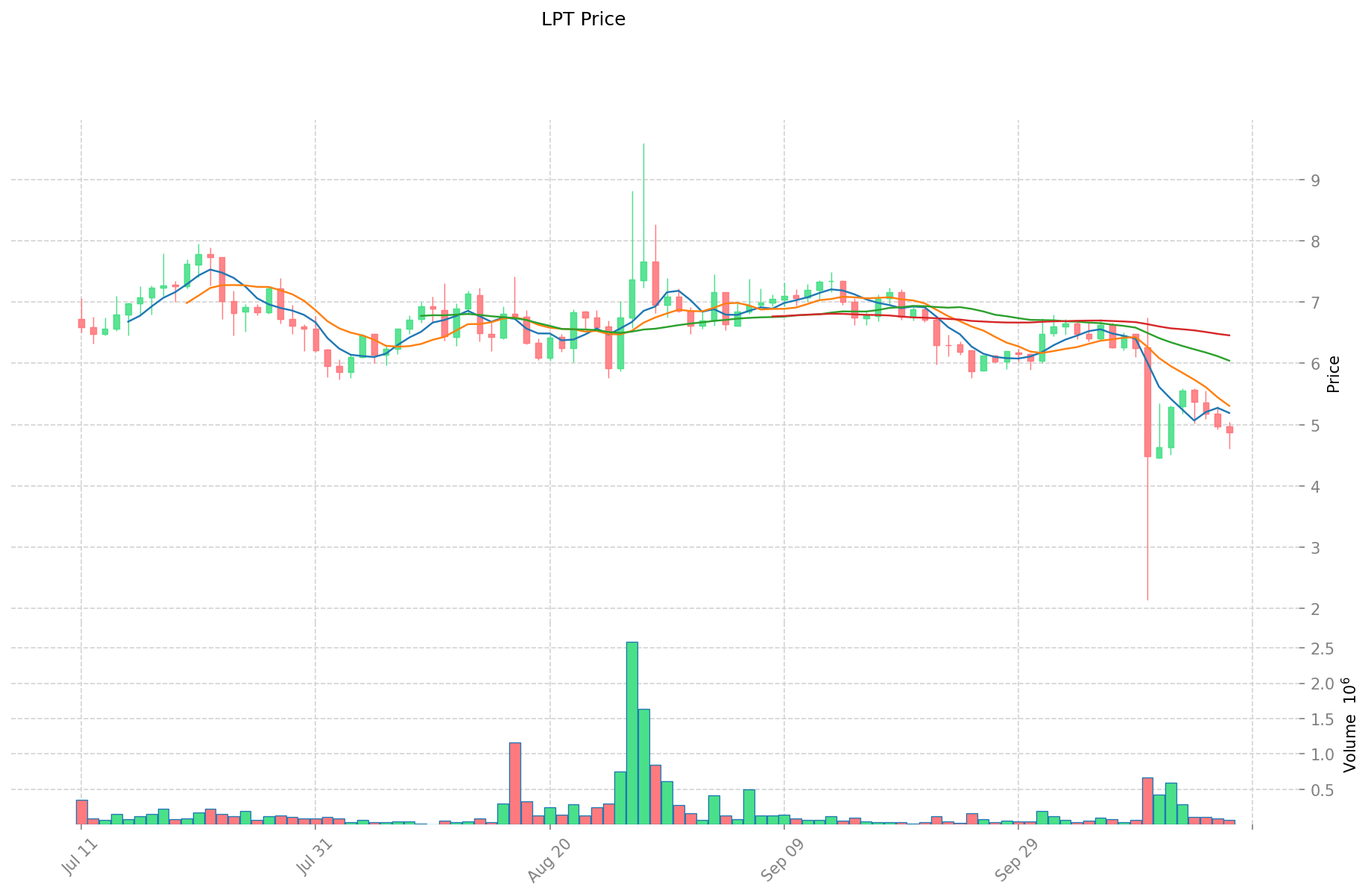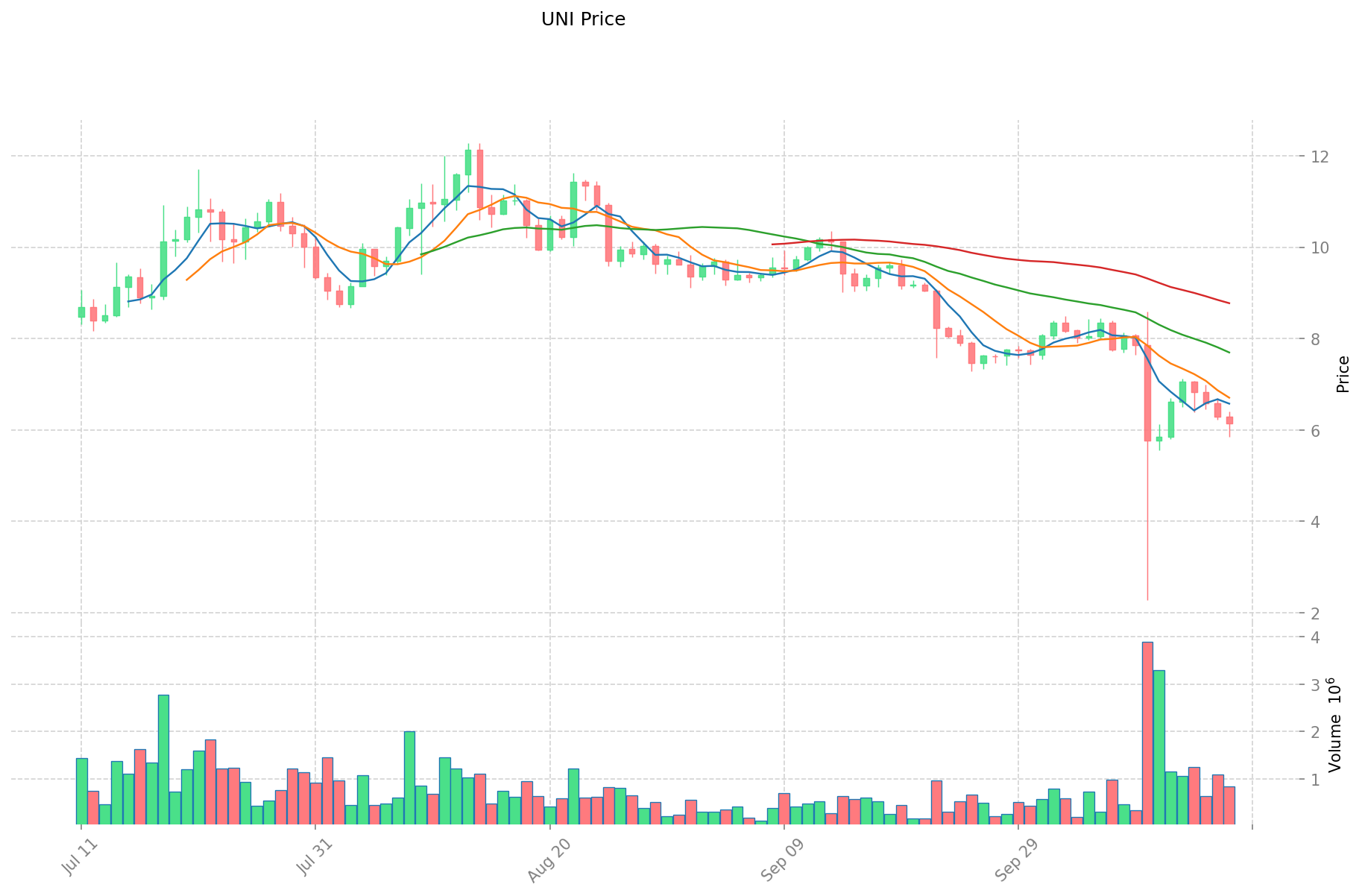LPT vs UNI: Comparing Two Popular Crypto Tokens in the DeFi Ecosystem
Introduction: LPT vs UNI Investment Comparison
In the cryptocurrency market, the comparison between Livepeer (LPT) and Uniswap (UNI) has always been a topic that investors cannot ignore. The two not only differ significantly in market cap ranking, application scenarios, and price performance, but also represent different positions in the crypto asset landscape.
Livepeer (LPT): Since its launch in 2018, it has gained market recognition for its open-source video streaming platform service based on the Ethereum blockchain.
Uniswap (UNI): Introduced in 2020, it has been hailed as the first automatic market-making transaction protocol on Ethereum, becoming one of the most traded and highest market cap cryptocurrencies globally.
This article will comprehensively analyze the investment value comparison between LPT and UNI, focusing on historical price trends, supply mechanisms, institutional adoption, technological ecosystems, and future predictions, attempting to answer the question most concerning to investors:
"Which is the better buy right now?"
I. Price History Comparison and Current Market Status
LPT (Coin A) and UNI (Coin B) Historical Price Trends
- 2021: LPT reached its all-time high of $99.03 on November 10, 2021.
- 2020: UNI was launched in September 2020, with its price starting at around $1.03.
- Comparative analysis: Since their respective peaks, LPT has fallen from $99.03 to its current price of $4.856, while UNI has dropped from its all-time high of $44.92 to $6.148.
Current Market Situation (2025-10-18)
- LPT current price: $4.856
- UNI current price: $6.148
- 24-hour trading volume: LPT $295,968.07 vs UNI $5,172,090.75
- Market Sentiment Index (Fear & Greed Index): 23 (Extreme Fear)
Click to view real-time prices:
- Check LPT current price Market Price
- Check UNI current price Market Price


II. Core Factors Affecting LPT vs UNI Investment Value
Supply Mechanism Comparison (Tokenomics)
- Livepeer (LPT): Inflationary model with annual issuance that decreases over time. Started at approximately 26% annual inflation in 2018, gradually decreasing to current levels.
- Uniswap (UNI): Fixed maximum supply of 1 billion tokens, with 60% allocated to community members and the remaining 40% distributed to team, investors, and advisors over 4 years.
- 📌 Historical Pattern: LPT's decreasing inflation rate has historically created less selling pressure over time, while UNI's fixed supply with gradual unlocking periods has created more predictable market dynamics.
Institutional Adoption and Market Applications
- Institutional Holdings: UNI appears to have greater institutional adoption, with major holders including a16z, Paradigm, and various crypto-focused funds.
- Enterprise Adoption: LPT has gained traction with video streaming platforms seeking decentralized infrastructure, while UNI has broader adoption across the DeFi ecosystem as critical trading infrastructure.
- Regulatory Stance: Both tokens face regulatory uncertainty in the US, with UNI potentially facing more scrutiny as a DeFi token that could be classified as a security by some regulators.
Technical Development and Ecosystem Building
- LPT Technical Upgrades: Focus on improving video transcoding capabilities, reducing latency, and enhancing decentralization of the network.
- UNI Technical Development: Implementation of v3 with concentrated liquidity, fee tiers, and active liquidity management; exploring Layer 2 solutions for lower gas fees.
- Ecosystem Comparison: UNI has a significantly larger ecosystem with billions in TVL across multiple chains, while LPT has a more specialized ecosystem focused on video streaming infrastructure.
Macroeconomic Factors and Market Cycles
- Inflation Environment Performance: UNI may offer better speculative potential during market uptrends due to its position in DeFi, while LPT's utility-focused model might provide more stability during bearish periods.
- Macroeconomic Monetary Policy: Both tokens are affected by broader crypto market trends related to interest rates and dollar strength, with UNI showing higher correlation to overall market movements.
- Geopolitical Factors: Decentralized infrastructure services like Livepeer may benefit from increasing censorship concerns, while Uniswap's permissionless trading could see demand in regions with financial restrictions.
III. Price Prediction 2025-2030: LPT vs UNI
Short-term Prediction (2025)
- LPT: Conservative $2.67 - $4.86 | Optimistic $4.86 - $6.94
- UNI: Conservative $5.84 - $6.15 | Optimistic $6.15 - $6.45
Mid-term Prediction (2027)
- LPT may enter a growth phase, with expected prices $4.89 - $9.56
- UNI may enter a stable phase, with expected prices $4.58 - $7.48
- Key drivers: Institutional capital inflow, ETFs, ecosystem development
Long-term Prediction (2030)
- LPT: Base scenario $11.14 - $16.04 | Optimistic scenario $16.04+
- UNI: Base scenario $5.32 - $9.02 | Optimistic scenario $9.02 - $9.38
Disclaimer: This analysis is based on historical data and market projections. Cryptocurrency markets are highly volatile and unpredictable. This information should not be considered as financial advice. Always conduct your own research before making investment decisions.
LPT:
| 年份 | 预测最高价 | 预测平均价格 | 预测最低价 | 涨跌幅 |
|---|---|---|---|---|
| 2025 | 6.94408 | 4.856 | 2.6708 | 0 |
| 2026 | 8.260056 | 5.90004 | 3.1270212 | 21 |
| 2027 | 9.5580648 | 7.080048 | 4.88523312 | 45 |
| 2028 | 11.397107268 | 8.3190564 | 4.741862148 | 71 |
| 2029 | 12.42118311084 | 9.858081834 | 5.61910664538 | 103 |
| 2030 | 16.0410707602848 | 11.13963247242 | 8.8003096532118 | 129 |
UNI:
| 年份 | 预测最高价 | 预测平均价格 | 预测最低价 | 涨跌幅 |
|---|---|---|---|---|
| 2025 | 6.4533 | 6.146 | 5.8387 | 0 |
| 2026 | 7.181601 | 6.29965 | 5.8586745 | 2 |
| 2027 | 7.482094305 | 6.7406255 | 4.58362534 | 9 |
| 2028 | 9.6714494674 | 7.1113599025 | 6.5424511103 | 15 |
| 2029 | 9.6501153876925 | 8.39140468495 | 6.1257254200135 | 36 |
| 2030 | 9.3815904377741 | 9.02076003632125 | 5.322248421429537 | 47 |
IV. Investment Strategy Comparison: LPT vs UNI
Long-term vs Short-term Investment Strategies
- LPT: Suitable for investors focused on decentralized infrastructure and video streaming potential
- UNI: Suitable for investors interested in DeFi ecosystem growth and liquidity provision
Risk Management and Asset Allocation
- Conservative investors: LPT: 30% vs UNI: 70%
- Aggressive investors: LPT: 60% vs UNI: 40%
- Hedging tools: Stablecoin allocation, options, cross-token portfolio
V. Potential Risk Comparison
Market Risks
- LPT: Relatively lower liquidity and higher volatility
- UNI: High correlation with overall crypto market trends
Technical Risks
- LPT: Scalability, network stability
- UNI: Smart contract vulnerabilities, Layer 2 integration challenges
Regulatory Risks
- Global regulatory policies may have differing impacts on both tokens, with UNI potentially facing more scrutiny due to its role in DeFi
VI. Conclusion: Which Is the Better Buy?
📌 Investment Value Summary:
- LPT advantages: Specialized use case in video streaming, decreasing inflation rate
- UNI advantages: Larger ecosystem, higher institutional adoption, key DeFi infrastructure
✅ Investment Recommendations:
- New investors: Consider a balanced approach with higher allocation to UNI for its established market position
- Experienced investors: Explore LPT for potential growth in the video streaming sector while maintaining UNI exposure
- Institutional investors: Evaluate UNI for its liquidity and ecosystem importance, consider LPT as a diversification play
⚠️ Risk Warning: The cryptocurrency market is highly volatile, and this article does not constitute investment advice. None
VII. FAQ
Q1: What are the main differences between LPT and UNI in terms of their use cases? A: LPT is focused on decentralized video streaming infrastructure, while UNI is a key player in decentralized finance (DeFi) as an automated market maker protocol.
Q2: How do the supply mechanisms of LPT and UNI differ? A: LPT has an inflationary model with decreasing annual issuance, while UNI has a fixed maximum supply of 1 billion tokens with a gradual distribution schedule.
Q3: Which token has shown better price performance historically? A: UNI has generally shown better price performance and stability, with a current price of $6.148 compared to LPT's $4.856. However, both have experienced significant declines from their all-time highs.
Q4: How does institutional adoption compare between LPT and UNI? A: UNI appears to have greater institutional adoption, with major holders including a16z and Paradigm, while LPT has gained traction with video streaming platforms seeking decentralized infrastructure.
Q5: What are the key factors that could influence the future price of LPT and UNI? A: Key factors include technological developments, ecosystem growth, regulatory changes, macroeconomic conditions, and adoption rates within their respective niches (video streaming for LPT and DeFi for UNI).
Q6: How should investors approach allocating between LPT and UNI in their portfolio? A: Conservative investors might consider a 30% LPT to 70% UNI split, while more aggressive investors could opt for a 60% LPT to 40% UNI allocation, depending on their risk tolerance and belief in the growth potential of each token's ecosystem.
Q7: What are the main risks associated with investing in LPT and UNI? A: Key risks include market volatility, technical vulnerabilities, regulatory uncertainties, and competition within their respective sectors. UNI may face more regulatory scrutiny due to its role in DeFi, while LPT may have challenges with scalability and network stability.
Share
Content